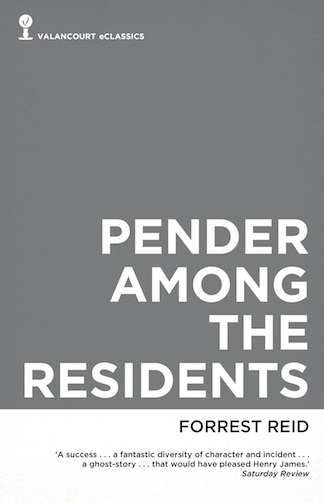VALANCOURT eCLASSICS SERIES

Pender among the Residents (1922)
Forrest Reid
Book Description
Wounded during the First World War, Rex Pender returns home to discover that he has inherited his grandfather’s mansion in the small Irish town of Ballycastle. As he seeks to recover his health, his peace is often interrupted by the local residents: the well-meaning but officious Dr. Olphert, the fourteen-year-old poet-prodigy Trefusis Heron, and Pender’s older cousin, Nellie Burton, who means to marry her daughter Norah to him. But Pender soon discovers himself to be among another group of residents as well: the ghosts of the dead haunt an old chamber, long disused, where a century earlier a tragedy played out, involving his great-grandfather Edward, his young wife, Roxana, and her lover. As Pender passes the period of his convalescence in piecing together the family history from dusty portraits and long-concealed letters, the haunted chamber begins to exercise its influence upon him, and the barrier that divides past from present and the living from the dead, begins to break down, leading to an eerie and unsettling climax . . .
Though best known for his tales of boyhood, Forrest Reid (1875-1947) was also a master of the supernatural tale in the tradition of Sheridan Le Fanu and Henry James’s The Turn of the Screw. Pender among the Residents (1922) is a highly entertaining story, told in the distinguished prose style for which Reid is celebrated, and featuring a delightfully ominous and dreadful sense of atmosphere that makes it perfect reading for a dark, chilly night.
$2.99 US Kindle
Forrest Reid
Book Description
Wounded during the First World War, Rex Pender returns home to discover that he has inherited his grandfather’s mansion in the small Irish town of Ballycastle. As he seeks to recover his health, his peace is often interrupted by the local residents: the well-meaning but officious Dr. Olphert, the fourteen-year-old poet-prodigy Trefusis Heron, and Pender’s older cousin, Nellie Burton, who means to marry her daughter Norah to him. But Pender soon discovers himself to be among another group of residents as well: the ghosts of the dead haunt an old chamber, long disused, where a century earlier a tragedy played out, involving his great-grandfather Edward, his young wife, Roxana, and her lover. As Pender passes the period of his convalescence in piecing together the family history from dusty portraits and long-concealed letters, the haunted chamber begins to exercise its influence upon him, and the barrier that divides past from present and the living from the dead, begins to break down, leading to an eerie and unsettling climax . . .
Though best known for his tales of boyhood, Forrest Reid (1875-1947) was also a master of the supernatural tale in the tradition of Sheridan Le Fanu and Henry James’s The Turn of the Screw. Pender among the Residents (1922) is a highly entertaining story, told in the distinguished prose style for which Reid is celebrated, and featuring a delightfully ominous and dreadful sense of atmosphere that makes it perfect reading for a dark, chilly night.
$2.99 US Kindle
reviews
‘He is a master hand at the creation of an atmosphere out of which something uncanny must develop and at making the supernatural seem not only possible but actual. There is no one writing today who exceeds him in the ability to deal effectively, persuasively, with occult themes.’ – New York Times
‘A success . . . a fantastic diversity of character and incident . . . a ghost-story . . . that would have pleased Henry James.’ – Saturday Review
‘Mr. Reid tells his slight story with unusual delicacy and charm. The interest of [the] novel lies not so much in the story he tells as in his manner of telling it and in the characters which he creates with a deftness and reality which give them a genuine hold on the memory.’ – Literary Review
‘A success . . . a fantastic diversity of character and incident . . . a ghost-story . . . that would have pleased Henry James.’ – Saturday Review
‘Mr. Reid tells his slight story with unusual delicacy and charm. The interest of [the] novel lies not so much in the story he tells as in his manner of telling it and in the characters which he creates with a deftness and reality which give them a genuine hold on the memory.’ – Literary Review
